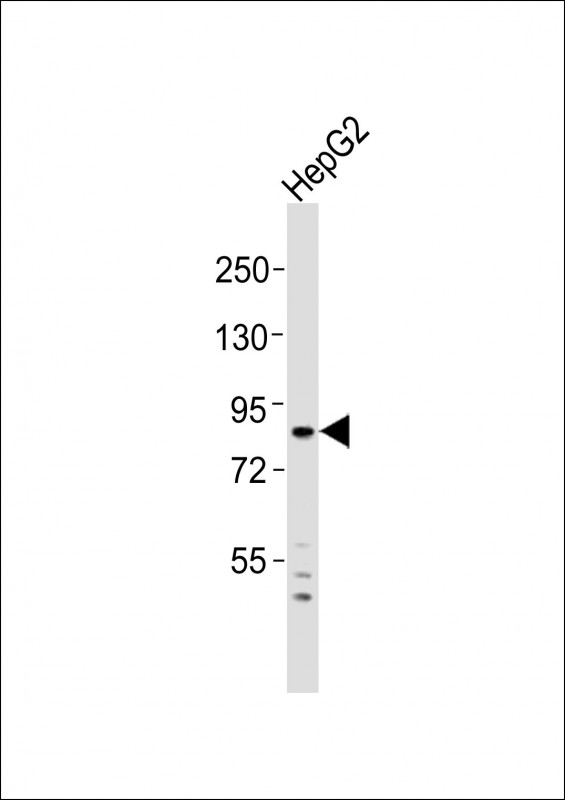ADAM15 Antibody (N-Term)
Purified Rabbit Polyclonal Antibody (Pab)
- 产品详情
- 实验流程
- 背景知识
Application
| WB, E |
|---|---|
| Primary Accession | Q13444 |
| Reactivity | Human |
| Host | Rabbit |
| Clonality | polyclonal |
| Isotype | Rabbit IgG |
| Calculated MW | 92959 Da |
| Gene ID | 8751 |
|---|---|
| Other Names | Disintegrin and metalloproteinase domain-containing protein 15, ADAM 15, 3424-, Metalloprotease RGD disintegrin protein, Metalloproteinase-like, disintegrin-like, and cysteine-rich protein 15, MDC-15, Metargidin, ADAM15, MDC15 |
| Target/Specificity | This ADAM15 antibody is generated from a rabbit immunized with a KLH conjugated synthetic peptide between 37-72 amino acids of human ADAM15. |
| Dilution | WB~~1:2000 E~~Use at an assay dependent concentration. |
| Format | Purified polyclonal antibody supplied in PBS with 0.09% (W/V) sodium azide. This antibody is purified through a protein A column, followed by peptide affinity purification. |
| Storage | Maintain refrigerated at 2-8°C for up to 2 weeks. For long term storage store at -20°C in small aliquots to prevent freeze-thaw cycles. |
| Precautions | ADAM15 Antibody (N-Term) is for research use only and not for use in diagnostic or therapeutic procedures. |
| Name | ADAM15 |
|---|---|
| Synonyms | MDC15 |
| Function | Active metalloproteinase with gelatinolytic and collagenolytic activity. Plays a role in the wound healing process. Mediates both heterotypic intraepithelial cell/T-cell interactions and homotypic T-cell aggregation. Inhibits beta-1 integrin-mediated cell adhesion and migration of airway smooth muscle cells. Suppresses cell motility on or towards fibronectin possibly by driving alpha-v/beta-1 integrin (ITAGV-ITGB1) cell surface expression via ERK1/2 inactivation. Cleaves E-cadherin in response to growth factor deprivation. Plays a role in glomerular cell migration. Plays a role in pathological neovascularization. May play a role in cartilage remodeling. May be proteolytically processed, during sperm epididymal maturation and the acrosome reaction. May play a role in sperm-egg binding through its disintegrin domain. |
| Cellular Location | Endomembrane system; Single-pass type I membrane protein. Cell junction, adherens junction. Cell projection, cilium, flagellum. Cytoplasmic vesicle, secretory vesicle, acrosome. Note=The majority of the protein is localized in a perinuclear compartment which may correspond to the trans-Golgi network or the late endosome. The pro-protein is the major detectable form on the cell surface, whereas the majority of the protein in the cell is processed (By similarity). |
| Tissue Location | Expressed in colon and small intestine. Expressed in airway smooth muscle and glomerular mesangial cells (at protein level). Ubiquitously expressed. Overexpressed in atherosclerotic lesions. Constitutively expressed in cultured endothelium and smooth muscle. Expressed in chondrocytes. Expressed in airway smooth muscle and glomerular mesangial cells. |
For Research Use Only. Not For Use In Diagnostic Procedures.
Provided below are standard protocols that you may find useful for product applications.
BACKGROUND
Active metalloproteinase with gelatinolytic and collagenolytic activity. Plays a role in the wound healing process. Mediates both heterotypic intraepithelial cell/T-cell interactions and homotypic T-cell aggregation. Inhibits beta-1 integrin-mediated cell adhesion and migration of airway smooth muscle cells. Suppresses cell motility on or towards fibronectin possibly by driving alpha-v/beta-1 integrin (ITAGV-ITGB1) cell surface expression via ERK1/2 inactivation. Cleaves E-cadherin in response to growth factor deprivation. Plays a role in glomerular cell migration. Plays a role in pathological neovascularization. May play a role in cartilage remodeling. May be proteolytically processed, during sperm epididymal maturation and the acrosome reaction. May play a role in sperm-egg binding through its disintegrin domain.
REFERENCES
Kraetzschmar J.,et al.J. Biol. Chem. 271:4593-4596(1996).
Herren B.,et al.FASEB J. 11:173-180(1997).
Charrier L.,et al.Am. J. Physiol. 288:G346-G353(2005).
Kleino I.,et al.BMC Mol. Biol. 8:90-90(2007).
Zhong J.L.,et al.Mol. Cancer Res. 6:383-394(2008).
终于等到您。ABCEPTA(百远生物)抗体产品。
点击下方“我要评价 ”按钮提交您的反馈信息,您的反馈和评价是我们最宝贵的财富之一,
我们将在1-3个工作日内处理您的反馈信息。
如有疑问,联系:0512-88856768 tech-china@abcepta.com.























 癌症的基本特征包括细胞增殖、血管生成、迁移、凋亡逃避机制和细胞永生等。找到癌症发生过程中这些通路的关键标记物和对应的抗体用于检测至关重要。
癌症的基本特征包括细胞增殖、血管生成、迁移、凋亡逃避机制和细胞永生等。找到癌症发生过程中这些通路的关键标记物和对应的抗体用于检测至关重要。 为您推荐一个泛素化位点预测神器——泛素化分析工具,可以为您的蛋白的泛素化位点作出预测和评分。
为您推荐一个泛素化位点预测神器——泛素化分析工具,可以为您的蛋白的泛素化位点作出预测和评分。 细胞自噬受体图形绘图工具为你的蛋白的细胞受体结合位点作出预测和评分,识别结合到自噬通路中的蛋白是非常重要的,便于让我们理解自噬在正常生理、病理过程中的作用,如发育、细胞分化、神经退化性疾病、压力条件下、感染和癌症。
细胞自噬受体图形绘图工具为你的蛋白的细胞受体结合位点作出预测和评分,识别结合到自噬通路中的蛋白是非常重要的,便于让我们理解自噬在正常生理、病理过程中的作用,如发育、细胞分化、神经退化性疾病、压力条件下、感染和癌症。






